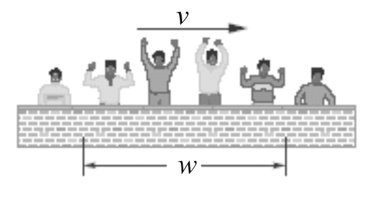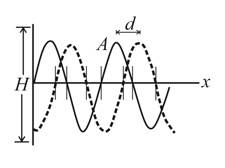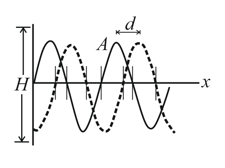A human wave. During sporting events within large, densely packed stadiums, spectators will send a wave (or pulse) around the stadium (in the figure shown below). As the wave reaches a group of spectators, they stand with a cheer and then sit. At any instant, the width of the wave is the distance from the leading edge (people are just about to stand) to the trailing edge (people have just sat down). Suppose a human wave travels a distance of 853 seats around a stadium in , with spectators requiring about to respond to the wave's passage by standing and then sitting. What are (a) the wave speed (in seats per second) and (b) width w (in number of seats)?


Important Questions on Waves-I
What are (a) the wave speed and (b) the tension in the string?
Use the wave equation to find the speed of a wave given by

In the figure shown below a string, tied to a sinusoidal oscillator at and running over a support at is stretched by a block of mass Separation linear density and the oscillator frequency . The amplitude of the motion at is small enough for that point to be considered a node. A node also exists at . (a) What mass allows the oscillator to set up the fourth harmonic on the string? (b) What standing wave mode, if any can be set up if

In the figure shown below, a sinusoidal wave moving along a string is shown twice as crest travels in the positive direction of an axis by distance in . The tick marks along the axis are separated by height The equation for the wave is in the form so what are and
(d) the correct choice of sign in front of

In the figure shown below a string, tied to a sinusoidal oscillator at and running over a support at , is stretched by a block of mass . The separation between and is and the frequency of the oscillator is fixed at . The amplitude of the motion at is small enough for that point to be considered a node. A node also exists at A standing wave appears when the mass of the hanging block is or , but not for any intermediate mass. What is the linear density of the string?

.
